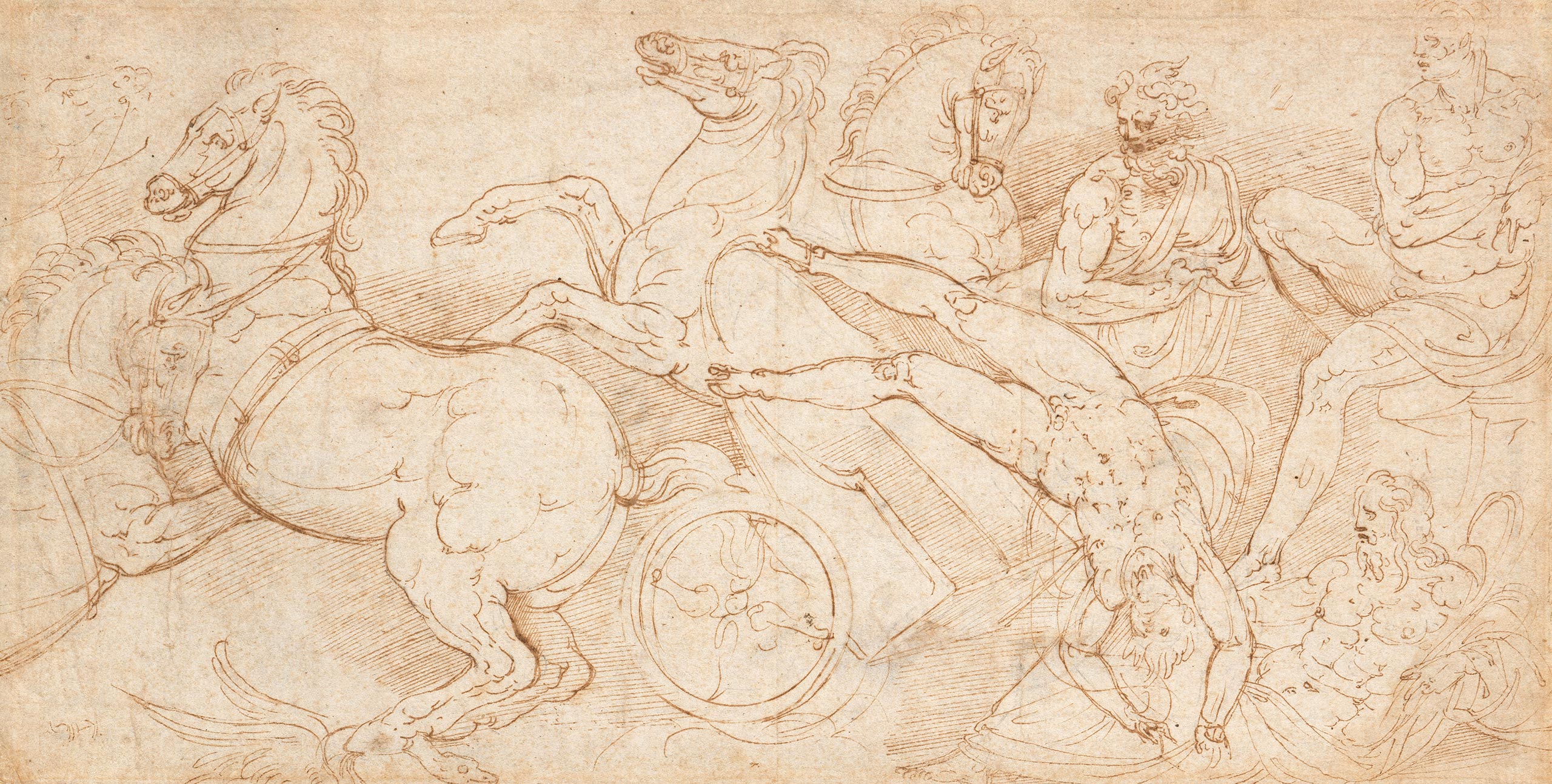
Franco
Battista
Venice 1510 — 1561
The fall of Phaeton or The Chariot races of the Circus Maximus
Pen and brown ink on laid down paper.
151 x 299 mm (5 15/16 x 11 13/16 in.)
Despite his Venetian origins, Battista Franco was educated in Rome. There he entered the circle of Michelangelo’s followers and took part in the ephemeral decorations for the triumphal entries of Charles V in Rome and Florence for the wedding of Eleonora of Toledo and Cosimo I de’ Medici in 1539 in Florence. In 1545, after a brief return to Rome in the early 1540s, he entered the service of Guidolbadlo II della Rovere, the Duke of Urbino and patron of famous Titian’s Venus of Urbino. These years of service, during which he was the master of the young Federico Barocci, did not prevent him from taking part in various works in Rome in 1548 and 1550, including the decoration of the façade of Cardinal Federico Cesi’s palace and the Gabrielli chapel in Santa Maria sopra Minerva. Around 1552, he returned to his native city, where he left a Baptism of Christ in San Francesco della Vigna and the ceiling decorations in the summer room at the Fondaco dei Tedeschi and the Biblioteca Marciana. He also worked on the Doge’s Palace and the Grimani Chapel in San Francesco della Vigna, which was completed by Federico Zuccaro after his death.
A prolific draughtsman, Franco was much sought-after by collectors over the following centuries. Giorgio Vasari noted his numerous copies from Antiquity, “not only statues but all the antiquities of the city”, a number of which he owned, assembled in an album. Franco’s interest in ancient remains continued throughout his life, which makes it difficult to date the sheets precisely. The sarcophagus he copied here, a Greek marble that has been restored in several places, is now in the Uffizi Museum in Florence (Fig. 1; Inv. 181). But it was in Rome that Franco saw this sarcophagus, where in the mid-16th century it stood to the right of the main door of Santa Maria in Aracoeli. It belonged to the Colonna family in the second half of the 16th century, as Onofrio Panvinio reported in 1600 that it was in Rome, in the Colonna family garden (“in hortis familiae Columnensium cardinalis Borromei ad SS Apostolos”). Acquired by the Medici without us knowing when or how, it is mentioned by Anton Francesco Gori and located in the gardens of the Villa Pratolino, from where it was later transported to the Uffizi Gallery, first in the entrance to the gallery (Lanzi) and then in the second corridor, where it remains to this day.
The rest of the composition sculpted on the sarcophagus, from the left-hand edge to the scene of Phaeton falling, is represented on a drawing kept at the Fondation Custodia that was once given to Franco, but also to Giulio Romano, and is now catalogued as Girolamo da Carpi. Despite the prestigious provenance of this sheet (Nicholas Lanier, Jonathan Richardson senior, Horace Walpole, Henri Fuseli), the draughtsmanship is much weaker than Franco’s, which is highly recognisable for its “sharp, effective line and its combination of Michelangelesque and Raphaelesque forms”, as A. E. Popham writes. Carpi and Franco shared the same interest in Antiquity, and their graphic style is quite similar, as Mariette points out, especially when they copy reliefs, the contours marked with a pen stroke and the backgrounds filled with hatching. Here, the style is particularly comparable to that of two sheets by Franco, among others, preserved in the Louvre: Copy of an antique sarcophagus relief with Marsyas defying Apollo (Inv. 4938) and A Roman soldier showing mercy to a barbarian family (Inv. 5010), both dated by Ann Varick Lauder to the years 1550-52. We are grateful to Anne Varick Lauder who kindly confirmed the attribution and datation of our drawing on the basis of a photograph and will include it in her forthcoming catalogue raisonné.

